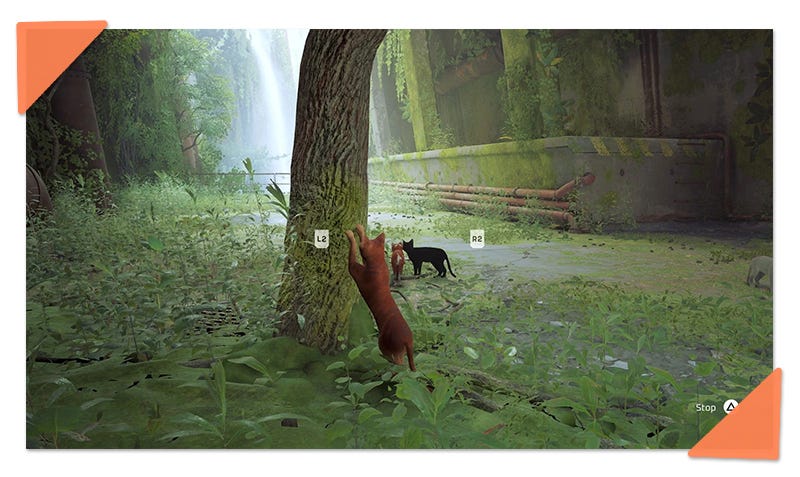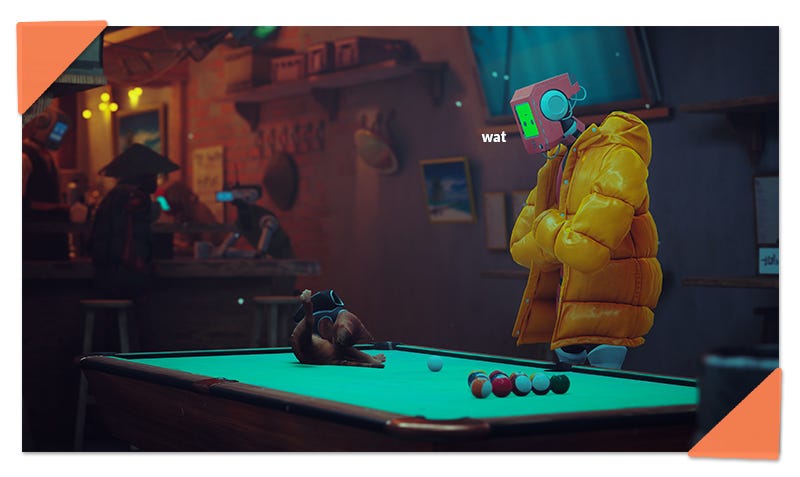Stray Isn’t a Cat Story
Understand the difference between a game’s hook and its heart to make experiences that stick.
Wouldn’t we all love to make games that become an instant classic as soon as they’re announced?
The development of Stray began in 2015, and it was amassing fans on its social media gradually (while it was known as the “HK Project”) until it suddenly became a mainstream hit after its announcement trailer popped in the (not-)E3 2020 Playstation conference. Players were immediately sold on the idea of embodying a cat; most of the comments below the trailer can testify.
The cat was also the tree masking a forest: the mysterious post-apocalyptic urban setting was less frequently mentioned but equally appealing. It turned out to be the true main character of this story-based adventure.
Stray is a textbook example of a multi-layered creation. Therefore, it makes an ideal case study to observe the distinction between the hook and the heart and why making this difference is essential, both for marketing & development.
So, You Want to Make a Cat Game?
Cats’ popularity never declined on the internet, so you may tell yourself “a game where you play as a cat could both stand out from the human-protagonist norm and yet appeal to players”.
Congratulations, you just discovered a hook, a catch-all marketing term which refers to a memorable aspect of a game. Hooks can come from the art, the sound, the rules, the unusual use of a feature, a mash-up of genre, etc. The stronger hooks are those that are desirable, surprising & straightforward. A cat protagonist ticks these boxes.
Hooks have always been important, but even more so in the modern gaming landscape where all games compete on the same digital marketplace. If you don’t stand out, players already have more than enough competitors’ games to pick from. Moving players through a classic marketing funnel is hard: you must give your audience good reasons why reading the description or watching your trailer is even worth their time and attention.
Great hooks aren’t a magic shortcut to skip all the steps: if the game’s genre or the quality isn’t to your audience’s liking, their initial attention can fade. When it works, however, it’s a sort of cheat code. Social virality increases and people are effortlessly attracted to click on your trailers.
Working with solid hooks helps you to reach an audience, but it’s far from the finish line: you still need to deliver a complete & cohesive experience. Some hooks which look appealing in a 2 minutes video may turn out to be gimmicks. You need something more: a solid heart that will carry the experience beyond the initial thrill of playing with the toy. In video games, an interactive medium, the heart is most often a progression to mastery: introducing complexity over time to increase the challenge.
Identifying the Heart
Stray barely has any challenges & progression though. Instead, it delivers what it promises directly: in the first minutes, you are with your cat friends, walking on ledges, lapping rainwater, cuddling and scratching your paws. These mechanics are fun & instantly likeable. The gameplay won’t evolve for the remainder of the adventure, but it’s okay; there isn’t enough depth in those mechanics to sustain much more than some simple environmental puzzles anyway.
To keep the player’s interest, the game quickly introduces its true heart: the mystery surrounding the walled city. With its fascinating dark neon atmosphere, this world is the real protagonist of your adventure. The characters you meet, the places you visit, the situations you encounter are all designed to tell the city's story. You keep playing is to discover its secrets: what happened, where the humans are, and who the robots are. Of course, the cat is still there, it’s always there, but it doesn’t drive the story.
In the case of Stray, here’s what the story’s structure looks like (skip to the next part if you don’t want spoilers!).
Yes, the cat is present throughout (the top line), but it barely drives the story: its initial problem (being separated from its cat friends) isn’t even adequately solved at the end (which disappointed a lot of players). In story-telling terms, the cat has a flat character arc: it doesn’t go through evolution itself but drives others and the world around to change. The major plot points, those emotional moments emphasized by cinematics are almost all related to the city.
Focused Efforts & Aligning Expectations
Why should you care? It’s not a revelation that Stray’s immense success has much to do with its setting and not just with the cat. I believe that figuring out your game's heart is important for at least three reasons.
First, deth is critical in games, and I’m not talking just about the system’s complexity, but about the intensity & sustained of the emotions you can deliver.
When your game revolves entirely around a single hook, most of the emotions come at the start (sometimes even before playing: excitement & anticipation), and then decrease over time. It doesn’t mean you should delay the interesting parts or spread the marmalade thin, but you must realise that the joy of discovery is always temporary.
Second, identifying the heart of your game lets you plan and prioritise the important content, locations, and elements you need to introduce. In the case of Stray, I don’t know if the team had to cut content, but I can tell that everything that made it to the final game has a clear purpose and contributes meaningfully to the city’s story, the central arch of the game. Did they need more locations & events with the cat outside the city? Definitely not. Knowing the role of your hook lets you prioritise the right things.
Third, distinguishing the hook from the heart helps you reconcile marketing & artistic ambitions. Even if you know what makes your game actually special, always remember what you used to drive people towards it. It’s a tricky prospect, especially when people come up with expectations you never planned to meet.
Remember when The Last of Us was announced, and it was cool because the zombie survival theme was popular at the time? It was their hook, and it was absolutely a focus, but the heart we all loved was Joel/Ellie’s relationship.
When you build a bridge between the hook & the heart, you do not disappoint players and can embark them on a journey they’ll never forget.
One Last Word
While writing this, I simplified on purpose and you may have been thinking “but the city & the mystery of robots were hooks too; it wasn’t hidden!”.
It’s true. A game will have multiple hooks that work on different people. The same goes for the heart; players have different preferences & reasons to keep playing. Players will have several reasons to be intrigued, and what attracts one may deter another.
Classifying features in hooks & heart categories denatures the incredible richness of your audience’s taste & emotion. So, always be careful when trying to explain why a game attracts & retains an audience: it’s always more nuanced than it looks.
If you liked the topic of this article, I’m sure you’d also enjoy this one:














Well written and an interesting read. I'm also curious what you used to illustrate the narrative structure. Is that manually done or did you use a story mapping tool? Simple and very effective.
Very interesting reading thanks